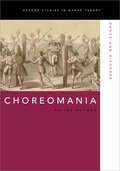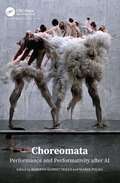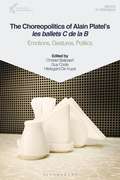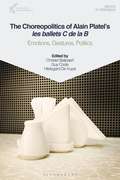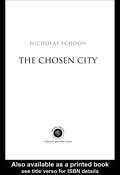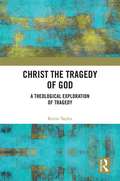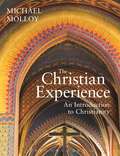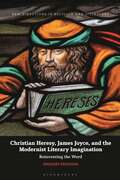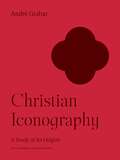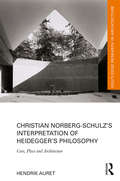- Table View
- List View
CHOREOMANIA OSDT C: Dance and Disorder (Oxford Studies in Dance Theory)
by Kélina GotmanWhen political protest is read as epidemic madness, religious ecstasy as nervous disease, and angular dance moves as dark and uncouth, the 'disorder' being described is choreomania. At once a catchall term to denote spontaneous gestures and the unruly movements of crowds, 'choreomania' emerged in the nineteenth century at a time of heightened class conflict, nationalist policy, and colonial rule. In this book, author Kélina Gotman examines these choreographies of unrest, rethinking the modern formation of the choreomania concept as it moved across scientific and social scientific disciplines. Reading archives describing dramatic misformations-of bodies and body politics-she shows how prejudices against expressivity unravel, in turn revealing widespread anxieties about demonstrative agitation. This history of the fitful body complements stories of nineteenth-century discipline and regimentation. As she notes, constraints on movement imply constraints on political power and agency. In each chapter, Gotman confronts the many ways choreomania works as an extension of discourses shaping colonialist orientalism, which alternately depict riotous bodies as dangerously infected others, and as curious bacchanalian remains. Through her research, Gotman also shows how beneath the radar of this colonial discourse, men and women gathered together to repossess on their terms the gestures of social revolt.
Choreomata: Performance and Performativity after AI
by Roberto Alonso TrilloIs artificial intelligence (AI) becoming more and more expressive, or is human thought adopting more and more structures from computation? What does it mean to perform oneself through AI, or to construct one’s subjectivity through AI? How does AI continue to complicate what it means to have a body? Has the golden age of AI, especially with regards to creative applications, already ended? Choreomata: Performance and Performativity after AI is a book about performance and performativity, but more specifically, it is a book about the performance of artificiality and the performance of intelligence. Both humans and human-designed computational forces are thoroughly engaged in an entangled, mutual performance of AI. Choreomata spins up a latticework of interdisciplinary thought, pairing theoretical inquiry from philosophy, information theory, and computer science with practical case studies from visual art, dance, music, and social theory. Through cross-disciplinary proportions and a diverse roster of contributors, this book contains insights for computer scientists, social scientists, industry professionals, artists, and beyond.
Choreomata: Performance and Performativity after AI
Is artificial intelligence (AI) becoming more and more expressive, or is human thought adopting more and more structures from computation? What does it mean to perform oneself through AI, or to construct one’s subjectivity through AI? How does AI continue to complicate what it means to have a body? Has the golden age of AI, especially with regards to creative applications, already ended? Choreomata: Performance and Performativity after AI is a book about performance and performativity, but more specifically, it is a book about the performance of artificiality and the performance of intelligence. Both humans and human-designed computational forces are thoroughly engaged in an entangled, mutual performance of AI. Choreomata spins up a latticework of interdisciplinary thought, pairing theoretical inquiry from philosophy, information theory, and computer science with practical case studies from visual art, dance, music, and social theory. Through cross-disciplinary proportions and a diverse roster of contributors, this book contains insights for computer scientists, social scientists, industry professionals, artists, and beyond.
Choreophonien: Konstellationen von Stimme und Körper im Tanz der Moderne und der Gegenwart (TanzScripte #68)
by Julia OstwaldDie Stimme stellt eine konstitutive, aber vernachlässigte Kategorie im Denken über Tanz dar. Anhand von Fallstudien aus dem modernen und zeitgenössischen euroamerikanischen Bühnentanz untersucht Julia Ostwald diverse Stimm-Körper-Konstellationen, die kanonisierten Setzungen von Tanz als stummer Kunstform entgegenlaufen. Mithilfe der Denkfigur der Choreophonien analysiert sie spezifische Verschränkungen von ästhetischen Verfahren, sinnlichen Wahrnehmungen und ihren mikropolitischen Dimensionen. Somit erschließt sie ein tanzwissenschaftliches Forschungsfeld, das nicht nur Impulse für Theorie und Praxis der performativen Künste, sondern auch für die Gender und Queer Studies gibt.
The Choreopolitics of Alain Platel's les ballets C de la B: Emotions, Gestures, Politics (Dance in Dialogue)
by Christel Stalpaert Guy Cools Hildegard De VuystLes Ballets C de la B was founded by Alain Platel in 1984. Since then it has become a company that enjoys great success at home and abroad. Over the years, Platel has developed a unique choreographic oeuvre. His motto, 'This dance is for the world and the world is for everyone', reveals a deep social and political commitment.Through the three topics of emotions, gestures and politics, this book unravels the choreopolitics of Platel's Les Ballets C de la B. His choreopolitics go beyond conveying a (political) message because rather than defending one opinion, Platel is more concerned about the exposure of the complexity within the debate itself. Highly respected scholars from different fields contribute to this book to provide an interdisciplinary perspective on the intense emotions, the damaged narratives, and the precarious bodies in Platel's choreographic oeuvre.
The Choreopolitics of Alain Platel's les ballets C de la B: Emotions, Gestures, Politics (Dance in Dialogue)
by Christel Stalpaert Guy Cools Hildegard De VuystLes Ballets C de la B was founded by Alain Platel in 1984. Since then it has become a company that enjoys great success at home and abroad. Over the years, Platel has developed a unique choreographic oeuvre. His motto, 'This dance is for the world and the world is for everyone', reveals a deep social and political commitment.Through the three topics of emotions, gestures and politics, this book unravels the choreopolitics of Platel's Les Ballets C de la B. His choreopolitics go beyond conveying a (political) message because rather than defending one opinion, Platel is more concerned about the exposure of the complexity within the debate itself. Highly respected scholars from different fields contribute to this book to provide an interdisciplinary perspective on the intense emotions, the damaged narratives, and the precarious bodies in Platel's choreographic oeuvre.
The Chosen City
by Nicholas SchoonThere is endless talk about the need for an urban renaissance; can it happen in the real world? In this broad, challenging and highly engaging book, Nicholas Schoon argues that the foremost priority for regeneration is to make neighbourhoods and cities places where people with choices choose to live.The author surveys the last two centuries of metropolitan growth and decay, analyzes the successes and failures of recent changes in urban policy and proposes a wide range of radical measures to make the renaissance a reality. Comprehensively researched, The Chosen City is a wake up call for everyone interested and involved in urban regeneration - degree students and academics, planning and housing professionals, architects, surveyors, developers and politicians. The text is illustrated with powerful black and white images from a leading national newspaper photographer.
The Chosen City
by Nicholas SchoonThere is endless talk about the need for an urban renaissance; can it happen in the real world? In this broad, challenging and highly engaging book, Nicholas Schoon argues that the foremost priority for regeneration is to make neighbourhoods and cities places where people with choices choose to live.The author surveys the last two centuries of metropolitan growth and decay, analyzes the successes and failures of recent changes in urban policy and proposes a wide range of radical measures to make the renaissance a reality. Comprehensively researched, The Chosen City is a wake up call for everyone interested and involved in urban regeneration - degree students and academics, planning and housing professionals, architects, surveyors, developers and politicians. The text is illustrated with powerful black and white images from a leading national newspaper photographer.
Chow Yun-fat and Territories of Hong Kong Stardom
by Lin FengAs one of the most popular and versatile Hong Kong film stars, Chow Yun-fat has enjoyed international success over the last four decades. Using Chow’s transnational and trans-regional star persona as a case study, Lin Feng investigates stardom as an agent for mediating the sociocultural construction of Hong Kong and Chinese identities. Through the analysis of Chow’s on- and off-screen star image, the book recognises that a star’s image is unstable and fragmented across distinct historical junctures, geographic borders and media platforms. Following Chow’s career move from Hong Kong to Hollywood, and then to transnational Chinese cinema, Chow Yun-fat and Territories of Hong Kong Stardom highlights the complex redefinitions of local and global, traditional and modern, and East and West, that Chow’s image has undergone, exploring the nature of Chinese and transnational stardom, the East Asian film industry, and Asian male stardom beyond martial arts and action cinema.
Chow Yun-fat and Territories of Hong Kong Stardom (Edinburgh University Press)
by Lin FengAs one of the most popular and versatile Hong Kong film stars, Chow Yun-fat has enjoyed international success over the last four decades. Using Chow’s transnational and trans-regional star persona as a case study, Lin Feng investigates stardom as an agent for mediating the sociocultural construction of Hong Kong and Chinese identities. Through the analysis of Chow’s on- and off-screen star image, the book recognises that a star’s image is unstable and fragmented across distinct historical junctures, geographic borders and media platforms. Following Chow’s career move from Hong Kong to Hollywood, and then to transnational Chinese cinema, Chow Yun-fat and Territories of Hong Kong Stardom highlights the complex redefinitions of local and global, traditional and modern, and East and West, that Chow’s image has undergone, exploring the nature of Chinese and transnational stardom, the East Asian film industry, and Asian male stardom beyond martial arts and action cinema.
Chris Marker (French Film Directors Series)
by Sarah CooperSince the early 1950s, Chris Marker has embraced different filmmaking styles as readily as he has new technologies, and has broadened conceptions of the documentary in distinctly personal ways. He has travelled around the world, tracking political upheavals and historic events, as well as unearthing the stories buried under official reporting. This globetrotting filmmaker testifies to his six decades on the move through a passionate devotion to the moving image. Yet from the outset, his filmic images reveal a fascination with stillness. It is at this juncture of mobility and immobility that Sarah Cooper situates her comprehensive study of Marker’s films. She pays attention to the central place that photographs occupy in his work, as well as to the emergence in his filming of statuary, painting and other static images, including the film still, and his interest in fixed frame shooting. She engages with key debates in photographic and film theory in order to argue that a different conception of time emerges from his filmic explorations of stasis. In detailed readings of each of his films, including Le souvenir d'un avenir andLa Jetee, Sans soleil and Level 5, Cooper charts Marker’s concern with mortality in varied historical and geographical contexts, which embraces the fragility of the human race, along with that of the planet.
Chris Marker (French Film Directors Series)
by Sarah CooperSince the early 1950s, Chris Marker has embraced different filmmaking styles as readily as he has new technologies, and has broadened conceptions of the documentary in distinctly personal ways. He has travelled around the world, tracking political upheavals and historic events, as well as unearthing the stories buried under official reporting. This globetrotting filmmaker testifies to his six decades on the move through a passionate devotion to the moving image. Yet from the outset, his filmic images reveal a fascination with stillness. It is at this juncture of mobility and immobility that Sarah Cooper situates her comprehensive study of Marker’s films. She pays attention to the central place that photographs occupy in his work, as well as to the emergence in his filming of statuary, painting and other static images, including the film still, and his interest in fixed frame shooting. She engages with key debates in photographic and film theory in order to argue that a different conception of time emerges from his filmic explorations of stasis. In detailed readings of each of his films, including Le souvenir d'un avenir andLa Jetee, Sans soleil and Level 5, Cooper charts Marker’s concern with mortality in varied historical and geographical contexts, which embraces the fragility of the human race, along with that of the planet.
Christ the Tragedy of God: A Theological Exploration of Tragedy
by Kevin TaylorTragedy is a genre for exploring loss and suffering, and this book traces the vital areas where tragedy has shaped and been a resource for Christian theology. There is a history to the relationship of theology and tragedy; tragic literature has explored areas of theological interest, and is present in the Bible and ongoing theological concerns. Christian theology has a long history of using what is at hand, and the genre of tragedy is no different. What are the merits and challenges of placing the central narrative of the passion, death and resurrection of Christ in tragic terms? This study examines important and shared concerns of theology and tragedy: sacrifice and war, rationality and order, historical contingency, blindness, guilt, and self-awareness. Theologians such as Reinhold Niebuhr, Hans Urs von Balthasar, Martin Luther King Jr., Simone Weil, and Boethius have explored tragedy as a theological resource. The historical relationship of theology and tragedy reveals that neither is monolithic, and both remain diverse and unstable areas of human thought. This fascinating book will be of keen interest to theologians, as well as scholars in the fields of literary studies and tragic theory.
Christ the Tragedy of God: A Theological Exploration of Tragedy
by Kevin TaylorTragedy is a genre for exploring loss and suffering, and this book traces the vital areas where tragedy has shaped and been a resource for Christian theology. There is a history to the relationship of theology and tragedy; tragic literature has explored areas of theological interest, and is present in the Bible and ongoing theological concerns. Christian theology has a long history of using what is at hand, and the genre of tragedy is no different. What are the merits and challenges of placing the central narrative of the passion, death and resurrection of Christ in tragic terms? This study examines important and shared concerns of theology and tragedy: sacrifice and war, rationality and order, historical contingency, blindness, guilt, and self-awareness. Theologians such as Reinhold Niebuhr, Hans Urs von Balthasar, Martin Luther King Jr., Simone Weil, and Boethius have explored tragedy as a theological resource. The historical relationship of theology and tragedy reveals that neither is monolithic, and both remain diverse and unstable areas of human thought. This fascinating book will be of keen interest to theologians, as well as scholars in the fields of literary studies and tragic theory.
Christensen Brothers: An American Dance Epic (Choreography and Dance Studies Series)
by Debra Hickenlooper SowellFirst Published in 1998. Routledge is an imprint of Taylor & Francis, an informa company.
Christensen Brothers: An American Dance Epic (Choreography and Dance Studies Series #Vol. 16)
by Debra Hickenlooper SowellFirst Published in 1998. Routledge is an imprint of Taylor & Francis, an informa company.
The Christian Experience: An Introduction to Christianity
by Michael MolloyHow do we study Christian life and thought? How have political and cultural events influenced the experiences of Christians in different places, at different times? How has the world's largest religion been lived in varied parts of the world?The Christian Experience is the first textbook to unite traditional approaches to Christianity with special attention to art, music, architecture, and lived experiences. The material, individual, and personal sides of Christianity are brought to the fore throughout this chronological survey. Every chapter begins with a "first encounter" in order to bring the subject matter to life for students, mirroring the author's approach in his successful book Experiencing the World's Religions. This book on Christianity features over 100 color images, maps, and diagrams, and each chapter ends by pointing to additional print and electronic resources.Michael Molloy considers practices, insights, and artistic creations of Christians across the centuries. The book shows how Christian belief is being practiced in our own time, and it invites readers to imagine how Christianity might evolve in the future.
The Christian Experience: An Introduction to Christianity
by Michael MolloyHow do we study Christian life and thought? How have political and cultural events influenced the experiences of Christians in different places, at different times? How has the world's largest religion been lived in varied parts of the world?The Christian Experience is the first textbook to unite traditional approaches to Christianity with special attention to art, music, architecture, and lived experiences. The material, individual, and personal sides of Christianity are brought to the fore throughout this chronological survey. Every chapter begins with a "first encounter" in order to bring the subject matter to life for students, mirroring the author's approach in his successful book Experiencing the World's Religions. This book on Christianity features over 100 color images, maps, and diagrams, and each chapter ends by pointing to additional print and electronic resources.Michael Molloy considers practices, insights, and artistic creations of Christians across the centuries. The book shows how Christian belief is being practiced in our own time, and it invites readers to imagine how Christianity might evolve in the future.
Christian Heresy, James Joyce, and the Modernist Literary Imagination: Reinventing the Word (New Directions in Religion and Literature)
by Gregory EricksonOrganized by heretical movements and texts from the Gnostic Gospels to The Book of Mormon, this book uses the work of James Joyce – particularly Ulysses and Finnegan's Wake – as a prism to explore how the history of Christian heresy remains part of how we read, write, and think about books today.Erickson argues that the study of classical, medieval, and modern debates over heresy and orthodoxy provide new ways of understanding modernist literature and literary theory. Using Joyce's works as a springboard to explore different perspectives and intersections of 20th century literature and the modern literary and religious imagination, this book gives us new insights into how our modern and “secular” reading practices unintentionally reflect how we understand our religious histories.
Christian Heresy, James Joyce, and the Modernist Literary Imagination: Reinventing the Word (New Directions in Religion and Literature)
by Gregory EricksonOrganized by heretical movements and texts from the Gnostic Gospels to The Book of Mormon, this book uses the work of James Joyce – particularly Ulysses and Finnegan's Wake – as a prism to explore how the history of Christian heresy remains part of how we read, write, and think about books today.Erickson argues that the study of classical, medieval, and modern debates over heresy and orthodoxy provide new ways of understanding modernist literature and literary theory. Using Joyce's works as a springboard to explore different perspectives and intersections of 20th century literature and the modern literary and religious imagination, this book gives us new insights into how our modern and “secular” reading practices unintentionally reflect how we understand our religious histories.
Christian How and Children by James Cranke Senior (tactile)
by RnibThe artist - James Cranke Senior (1707-1780) spent most of his life in Urswick near Ulverston. His painting style is said to have been influenced by GeorgeRomney. This oil on canvas painting dates to circa 1763. The painting This family portrait shows the family of Peter How, one of the 18th century richest merchants in the north of England. He made and lost his fortune through the tobacco trade. The painting features three members of Peter How's family, from left to right, Peter How's second wife Christian (seated), his son Peter (standing) and his daughter Christian (standing). A small table with pink and white flowers on top separates Peter from his sister. The background of the painting is very dark making the faces, necks, arms and hands really stand out as if illuminated. How's wife Christian is seated on the left of the painting, her body facing into the centre of painting with her face turned to look directly at you. Her hair is swept back off her face giving her a high forehead. The hair is gathered at the back in a tight pony tail, which was a typical fashion for this period. She has quite a serious expression on her face with a straight mouth. Her right lower arm is laid across her lap and she is holding a dainty blue and white teacup and saucer in her hand. Her left arm is laid gently and protectively across the shoulders of her son Peter who is standing at her side. Christian is wearing a long gold coloured dress that has a deep scooped neckline trimmed with white lace, fitted bodice, three-quarter length sleeves that are also trimmed with white lace and a voluminous skirt that takes up a great deal of room. Peter has his body facing you but his face turned very slightly to the right and looking away from you. He too has a serious expression with his hair swept back off his face revealing a high forehead. Once again his hair is gathered at the back in a ponytail. Leaning very slightly towards his mother, Peter's right arm is laid across her lap and he is holding a silver spoon upright in his hand. His left arm is bent at the elbow and is held across his body at waist height. Unusually for us, Peter is wearing a full length silver dress in a similar style to his mother. The lower part of his dress is hidden by the huge skirt of his mother's dress. It was usual at this time for boys to wear dresses until about the age of five, when they were "breeched" i.e. wore breeches (trousers). Peter's sister, Christian, is standing on the right of the painting with her body facing into the centre towards her mother and brother but separated from them by the small table with flowers on. Her head is turned so that she is looking directly at you and she has a less serious expression than that of her mother and brother with almost a smile visible. Her hair, decorated with flowers, is swept off her face like her mother revealing a high forehead. Christian is also wearing a silver dress that is matches her brother's dress. With her left hand, she has gathered up the front hem of dress's skirt revealing a bright red underskirt. In the folds of the skirt she is holding at waist height are flowers that she appears to be taking from or placing on the small table next to her. In her right hand, that is held out above the small table, she holds another flower.
Christian Iconography: A Study of Its Origins (The A. W. Mellon Lectures in the Fine Arts #10)
by André GrabarAn illuminating look at the iconography of the early church and its important place in the history of Christian artIn this book, historian André Grabar demonstrates how early Christian iconography assimilated contemporary imagery of the time. Grabar looks at the most characteristic examples of paleo-Christian iconography, dwelling on their nature, form, and content. He explores the limits of originality in such art, its debt to figurative art, and the broader cultural climate in the Roman Empire, drawing a distinction between expressive images—that is, genuine works of art—and informative ones. Throughout, Grabar establishes the importance of imperial iconography in the development of Christian portraits and sheds light on the role they played alongside other forms of Christian piety in their day.
Christian Norberg-Schulz’s Interpretation of Heidegger’s Philosophy: Care, Place and Architecture (Routledge Research in Architecture)
by Hendrik AuretChristian Norberg-Schulz’s Interpretation of Heidegger’s Philosophy investigates the theoretical contribution of the world-renowned Norwegian architectural theorist Christian Norberg-Schulz (1926 – 2000) and considers his architectural interpretation of the writings of German philosopher Martin Heidegger. Though widely recognised as providing the most comprehensive reading of Heideggerian philosophy through the lens of architecture, this book argues that Norberg-Schulz neglected one of the key aspects of the philosopher’s contributions: the temporal nature of being-in-the-world as care. The undeveloped architectural implications of the ontological concept of care in his work prevented the fruition of his ultimate aim, transforming the ‘art of place’ into an ‘art of living’. This book seeks to realign Norberg-Schulz’s understanding of time as continuity and change to present a holistic approach grounded in Heidegger’s phenomenological philosophy; architecture as art of care. Aimed at academics and scholars in architectural theory, history and philosophy, Christian Norberg-Schulz’s Interpretation of Heidegger’s Philosophy surveys the implications and significance of the theorist’s works on architectural criticism in the late 20th century.
Christian Norberg-Schulz’s Interpretation of Heidegger’s Philosophy: Care, Place and Architecture (Routledge Research in Architecture)
by Hendrik AuretChristian Norberg-Schulz’s Interpretation of Heidegger’s Philosophy investigates the theoretical contribution of the world-renowned Norwegian architectural theorist Christian Norberg-Schulz (1926 – 2000) and considers his architectural interpretation of the writings of German philosopher Martin Heidegger. Though widely recognised as providing the most comprehensive reading of Heideggerian philosophy through the lens of architecture, this book argues that Norberg-Schulz neglected one of the key aspects of the philosopher’s contributions: the temporal nature of being-in-the-world as care. The undeveloped architectural implications of the ontological concept of care in his work prevented the fruition of his ultimate aim, transforming the ‘art of place’ into an ‘art of living’. This book seeks to realign Norberg-Schulz’s understanding of time as continuity and change to present a holistic approach grounded in Heidegger’s phenomenological philosophy; architecture as art of care. Aimed at academics and scholars in architectural theory, history and philosophy, Christian Norberg-Schulz’s Interpretation of Heidegger’s Philosophy surveys the implications and significance of the theorist’s works on architectural criticism in the late 20th century.
Christianity and democratisation: From pious subjects to critical participants (PDF) (Perspectives on Democratic Practice)
by John AndersonThis book examines the contribution of different Christian traditions to the waves of democratisation that have swept various parts of the world in recent decades. It offers a historical overview of Christianity’s engagement with the development of democracy, before focusing in detail on the period since the 1970s. Successive chapters deal with: the Roman Catholic conversion to democracy and the contribution of that church to democratisation; the Eastern Orthodox ‘hesitation’ about democracy; the alleged threat to American democracy posed by the politicisation of conservative Protestantism; and the likely impact on democratic development of the global expansion of Pentecostalism. The author draws out several common themes from the analysis of these case studies, the most important of which is the ‘liberal-democracy paradox’. This ensures that there will always be tensions between faiths that proclaim some notion of absolute truth and political orders that are rooted in the idea of compromise, negotiation and bargaining. Written in an accessible style, this book will appeal to students of politics, sociology and religion, and prove useful on a range of advanced undergraduate and postgraduate courses.
